The final destination on a recent Mekong River Cruise was the famous Cambodian town of Siem Reap.
It is the primary gateway for the Angkor Archaeological Park, a UNESCO World heritage site since 1992.
Stretching over some 400 square kilometres, including forested area, Angkor Archaeological Park contains the magnificent remains of several capitals of the Khmer Empire of the 9th to the 15th centuries, including the largest pre-industrial city in the world. The most famous are the Temples of Angkor Wat, Angkor Thom, with its Bayon Temple, and Ta Prohm.
Angkor itself has no accommodation and few facilities and Siem Reap reacts as the tourist hub for the area.
My wife and I spent three days in Siem Reap and, as part of our package, were accommodated at the 5 Star Sofitel Angkor Phokeethra…

*****

…which proved to be an exceptional haven from our very busy schedule.
Needless to say Siem Reap attracts a lot of tourists and we got the general impression that every visitor’s taste is catered for. The town of Siem Reap is a vibrant place with a good balance of accommodation, restaurants, entertainment and relaxation…

At the top end of the accommodation scale are hotels like the Raffles Grand Hotel D’Angkor…


…while at the lower level of entertainment is the infamous ‘Pub Street’…

… along which bars and restaurants can range between the smooth(?)…

..and the rough…

Whatever the visitor’s taste though, there is always colour around Siem Reap. Nowhere is that more evident than at Wat Preah Prom Rath, on Pokambor Ave. The glittering modern temple grounds offer a blaze of colour while hinting at its 500 year history….

I also discovered that it was popular with other international tourists…
Dobry wieczór Polska…

A selection of some other street scenes I spotted in Seam Reap…

*****

…before I found the equally colourful food market. The Cambodians know how to eat…

…though maybe the UK’s Health and Safety may disagree…

And so to the serious business – Angkor.
Angkor Wat is of course Angkors ‘jewel in the crown’ and the most famous of the temples. And everybody wants to see that famous sunrise…
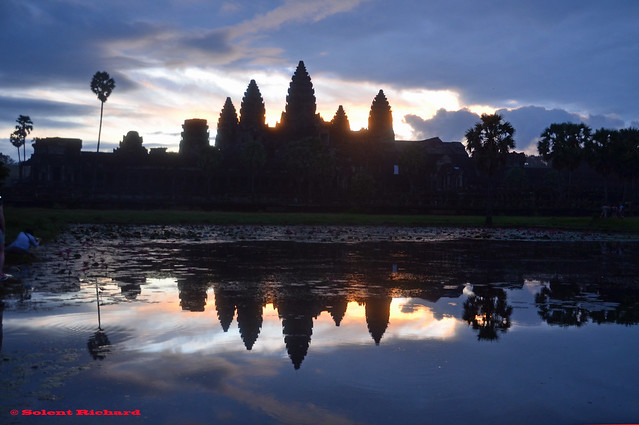
Yes, I mean everybody…


…including yours truly…

…even when it means getting up at 4 o’clock in the morning.
Angkor Wat is effectively a miniature replica of the universe in stone and was intended to be an earthly model of the cosmic world. The central tower rises from the centre of the monument symbolizing the mythical mountain, Meru, situated at the centre of the universe. Its five towers correspond to the peaks of Meru. The outer wall corresponds to the mountains at the edge of the world, and the surrounding moat the oceans beyond.
It was built by the Khmer King Suryavarman II in the early 12th century.
The main entrance is along a 250 metre sandstone causeway…

…and occupies a rectangular area of about 208 hectares (500 acres) defined by an outer protective wall.
Once sunrise had been witnessed our guide had a nice surprise up his sleeve, breakfast and bubbles…

And here is a tip I’m more than willing to share.
For some strange reason those masses of photographers seemed to disappear once the sun had risen and, on completion of our ‘post sunrise’ refreshment, this is the best time to enter Angkor Wat. It is virtually crowd free…

Another tip is to ensure you have a knowledgeable guide. It’s pretty essential if the visitor is to obtain the knowledge and history of this place. We were also fortunate enough to have our own Vox Box bluetooth receivers with us, supplied by our tour hosts. They too proved most useful when I dared wander off to capture that certain photograph.
And even though Angkor Wat is the most photographed Khmer monument, nothing approaches the actual experience of seeing this temple and having the information surrounding its history fully explained. They also have other uses as will be seen shortly.
At first glance Angkor Wat appears to be a mass of stone with a central causeway and is difficult to grasp when actually inside. It actually consists of a series of elevated courtyards, towers, covered galleries, chambers and porches and courtyards on different levels and all linked by stairways. The galleries and their columns set the boundaries for the first and second levels. The third level, The Temple, consists of five towers – one in each corner and a central one…

The outer wall gallery of the temple contains bas-reliefs that stretch for almost 600 metres. The western section of the gallery depicts several scenes from the Hindu Epic Mahabharata Images, hundreds of weapon bearing warriors engaged in combat…

…and a closer view…

The first courtyard has a good open aspect and contains, amongst other interesting features, four large pools – now drained – and the gallery of 1,000 Buddhas…

As the name suggests, this area used to have hundreds of Buddha images. Now only remnants remain as some were removed and others stolen…

*****

There’s a large ‘Buddha’ statue opposite the gallery entrance. The statue is actually Vishnu, the Hindu God, dressed as Buddha. Many visitors do come to pray and give their offerings while visiting Angkor Wat temple.

It reminds you once again what the temple is about. It was a religious structure then, and it is still one now, though maybe not on the scale it used to be.
The walls of the Gallery also boast thousands of Aspara dancer figures. From a distance these appear to be similar however, on closer inspection each one is different, no two the same…

The Middle Courtyard again boasts a walled gallery…
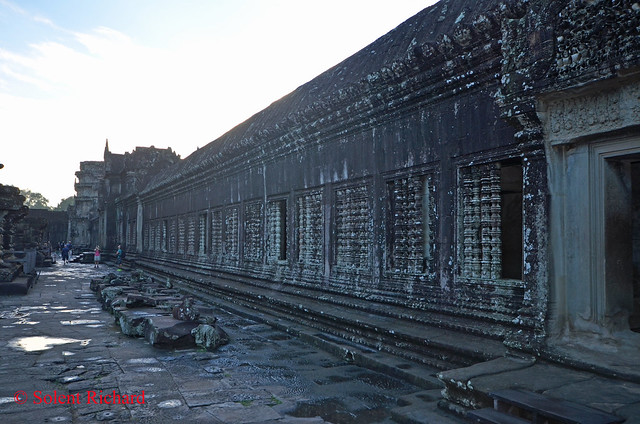
…and the opportunity to take in the sight of the towers of the central, third level, Temple itself…

Towers mark the corners of the second and third storeys and each is topped with symbolic lotus-buds…

…and the remains of a Wat (within a Wat)

So to the final level, known as ‘The Temple,’ and this is where our guide once again came into his own. A crowd of independent visitors had started to gather at the foot of the staircase leading to the Temple level…
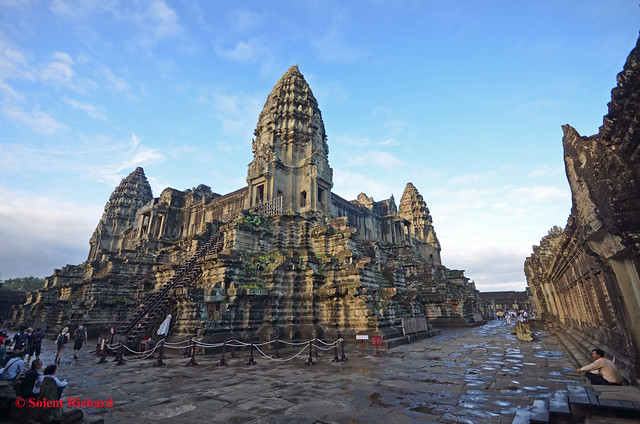
There is both limited and timed access…

Whatever the rules of entry are, our guide ensured that we were at the front of the queue and I was more than pleased to be able to sprint up those stairs in order to capture my wife leading our party…
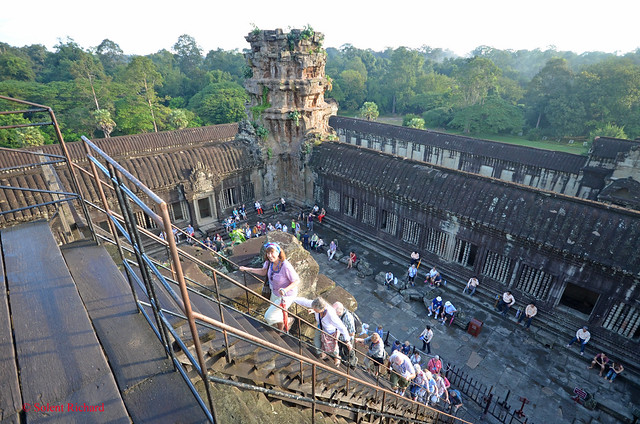
and getting really close to each of the five towers…

…really generates that feeling of being up there with the Gods.

Also, exploring the various upper galleries…

…and enjoying the views both down into the lower courtyards and out over Angkor Wat …

…made the steep ascent of those steps well worth the effort.
There are two other large archeological sites that should not be missed.
The first of the two is Angkor Thom.
Angkor Thom, the last capital of the Khmer Empire, was a fortified city enclosing residences of priest, officials of the palace and military, as well as buildings for administering the kingdom…
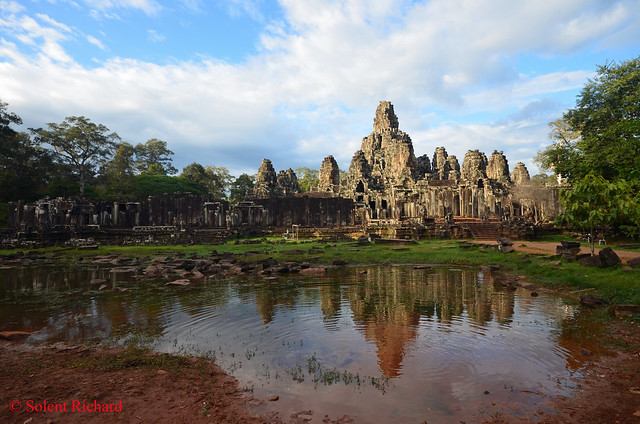
*****

The centre piece of Angkor Thom is the Bayon Temple…

*****

The Bayon was the state temple of King Jayavarman VII, dedicated to the Buddha.
Shaped like a pyramid its two most inspiring features are the several faces that adorn the towers and the bas-reliefs on the many gallery walls.
Bayon is unique among all Angkor period-ruins in its construction. It is encircled by fifty four towers each with faces carved on four sides…


That’s over 200 large enigmatic faces, each carved onto huge blocks of stone before being hoisted into position on those 54 towers and each gazing out in the cardinal directions. It is the feature that gives this temple its majestic character – faces with slightly curving lips and eyes placed in shadow by the lowered lids
Around the central tower were numerous shrines of Buddhist and Hindu Gods, for all Gods are venerated in the kingdom.

Another feature of Angkor Thom is the Terrace of the Elephants. The terrace was used as a platform from which King Jayavarman VII viewed his victorious returning armies, public ceremonies and also served as a base for the king’s grand audience hall.
Though most of what remains are just the foundation platforms of the complex, the 350 metre terrace still gives a clear impression of the grandeur of this area of Angkor Thom…

The central Dais from which the king undertook the reviews…

The elaborate carvings on the dais…

…and the view from on top…

The final piece in the Angkor jigsaw is Ta Prohm, the most mysterious of all the temple structures in Angkor…

Ta Prohm was originally a monastery – indeed, the most powerful in the kingdom.
Ta Prohm has been left in much the same condition in which it was found: the photogenic and atmospheric combination of trees growing out of the ruins and its jungle surroundings have made it one of Angkor’s most popular temples with visitors…

Probably more recognisable now of course as the location of the film, Tomb Raider...

*****

*****

*****

Well, why not…

There is no doubt as to the splendour and general appearance of the temples at Angkor. Their history is very impressive and there is a romanticism about visiting them. Apart from anything else there is a thrill that somehow one is caught up in this time warp.
In the world of edifices certainly Angkor Wat and Angkor Thom rank among the most impressive. There is a beauty and purpose here that the pyramids can never engender.
And there lies the problem. They have become more than very popular and while Siem Reap has expanded to cope with the influx of visitors there is no such option for the temples.
Visiting Angkor is possible by many means of transport and combining a visit with a river cruise along the Mekong River is but one.
There are however advantages. The Mekong cruise packages include the guided tours to the temples and without such guides so much of the history and romanticism will be lost.
There are of course local guides for hire and that is an option for those visitors not arriving or departing by river. Whatever one chooses there is no time like the present and certainly before those numbers of visitors reach epidemic proportions.
Visiting Angkor really is one of those ‘journey’s of a lifetime.’
If you have enjoyed this review of Siem reap and would like to be amongst the first to hear of new reviews (which will shortly include the Pacific Islands of Tahiti and Moorea and Portugal’s Oporto ) why not join the many other followers by clicking on the ‘Follow’ link on the front page. You will be alerted by email immediately a new post appears.

Excellent as always Richard. Wonderful photos and great historical context too. This is really on my hit list!
Richard,
This is awe-inspiring, I am lost for words!
You have an amazing ability to bring these parts of the world to people like myself, who will never be able to afford such a holiday.
I love your photography, as I have said before, and the photos of Angkor are stunning. Everything comes to life for me through your writing and photography.
Thank you Richard, you are the second David Attenborough, your work is truly wonderful.
nice informative post, really very helpful for me, thanks for share,
Pingback: Cruises.co.uk | Solent Richard's Cruise Blog·
Pingback: Cruising Mates | Solent Richard's Cruise Blog·